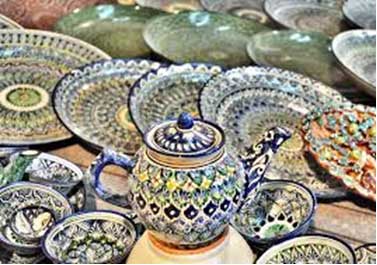Culture
 Uzbekistan is a historically and culturally rich country. In this region since ancient times were very developed all kinds of crafts. Among the many arts and crafts pottery holds a special place. This is one of the oldest and most sought-after cultural heritage of our people.
Uzbekistan is a historically and culturally rich country. In this region since ancient times were very developed all kinds of crafts. Among the many arts and crafts pottery holds a special place. This is one of the oldest and most sought-after cultural heritage of our people.
These various shapes and very comfortable in the hand-lagans, plates, bowls and braids, vases, hums and kettles, pots and painted toys are always in demand to this day. Today, they are characterized by high craftsmanship, harmony of wildest imagination, amazing magic ornamental solutions and exquisite sense of style in dealing with color.
In our country, made unglazed fired terracotta and glazed ceramics. Each ceramic school is not only a certain type of manufactured products, the presence of unique patterns, modeling techniques, firing and coloring, but also for its range of colors. Over the centuries crafts of such centers as Tashkent, Samarkand, Khorezm, Gijduvan and Rishtan clearly defined and became known.
Ceramics divided into blue, green and white colors, as well as green, brown and yellow. Such taste preferences are explained by purely technical reasons.
In Fergana valley and Khorezm for cover of ceramics they use old ishkor glaze azure tones, but yellow-brown tones of natural dyes under it just decompose.
In Samarkand, Tashkent and Bukhara they use lead-glaze, so there is the whole range of wonderful turns reddish brown.
It should be noted that the Tashkent pottery holds a special position among other pottery centers of Uzbekistan. As a school of ceramic art Tashkent historically moved relatively recently, only in the XIX century. But now, because of their position – the capital of the republic, it became the center of the search for new ways of development of ceramics.
Several thousand years ago in Samarkand region one of the earliest centers of pottery was founded. To our time on the ruins of Afrasiab preserved painted glazed ceramic bowls and a variety of local clay figurines of deities and fantastic animals created by the hands of masters of the legendary Sogdiana. Formed style here reflects the characteristic features of the artistic traditions of an era and influenced many of the centers of ceramics in the region.
Afrasiab glazed ceramics differs with artistic and technical excellence, as evidenced by the high quality of the crock, glazes and paints, perfection of forms and decor. Manufactures dishes were open and closed forms. For decorative products are characterized by elegance and fine sense of color.
The new flourishing of glazed ceramics of Samarkand is closely related to the era Timurids. At this time the city is still the largest center of ceramic production in the region. It was here, in the capital, is the addition of a new style of ceramic decoration, which had a decisive influence on the products of other pottery centers – Tashkent, Bukhara, Shakhrisabz, Merv, Nisa. Unlike Afrasiab ceramics, the design of which was dominated by epigraphy and geometric patterns, the new style is characterized by the dominance of a realistic start.
One of the oldest schools in Khorezm ceramics is that a clear timetable is different monumental geometric ornament. Patterns of pottery decorated with lively echo majolica covering the walls of the famous landmarks of ancient Ichan-Kala. Today’s artisans are direct descendants of the folk artists that adorned the Khan’s palace and the mosque.
Modern kulols (potters) use the same natural ingredients for glaze-ishkor what their ancestors used to manufacture unfading blue, blue, turquoise tiles.
It should be noted that due to the special territorial isolation of Khorezm, a local ceramic style is almost not changed and extraneous influences. It came to us through the millennia in intact form.
Pottery and dishes from Rishtan Fergana valley are the most popular in Uzbekistan. Thin ringing covered exquisite ornamentation products can be purchased in Uzbekistan everywhere.
Rishton is the oldest center of ceramic art in Central Asia. There has developed a unique technology for creating pottery. Local pottery has its own forms, motifs and colors. For pottery Rishtan in coloring characterized by the use of turquoise, dark blue and brown on a milky white background.
In Gijduvan ceramics are about 60 traditional forms of products. Equally traditional arsenal and ornamental forms, which includes more than 300 drawings resistant. These variations make it possible to create new and new compositions, the freedom to exercise creative imagination within the tradition.
The main features of Gijduvan Ceramics – a characteristic greenish-brown range, like which incorporates natural colors edge, figurative painting and abr divorce, echoing patterns popular Uzbek fabrics. Unusually warm in color with a golden tint velvety color gives a unique charm ceramics – interspersed with precious look on it yellow, green and blue parts of the ornament.

























